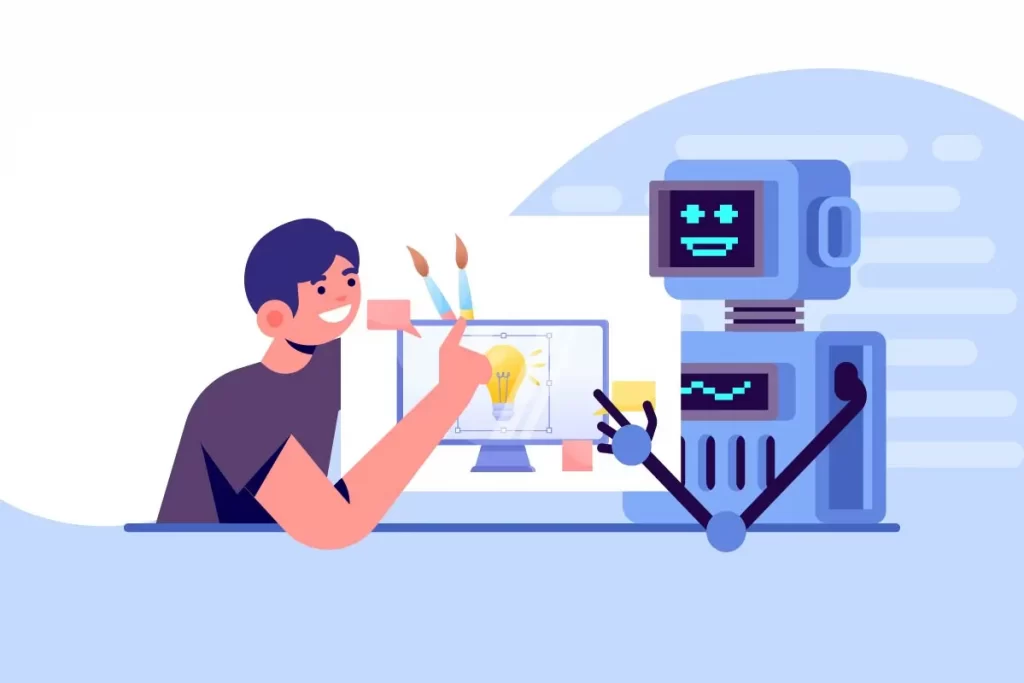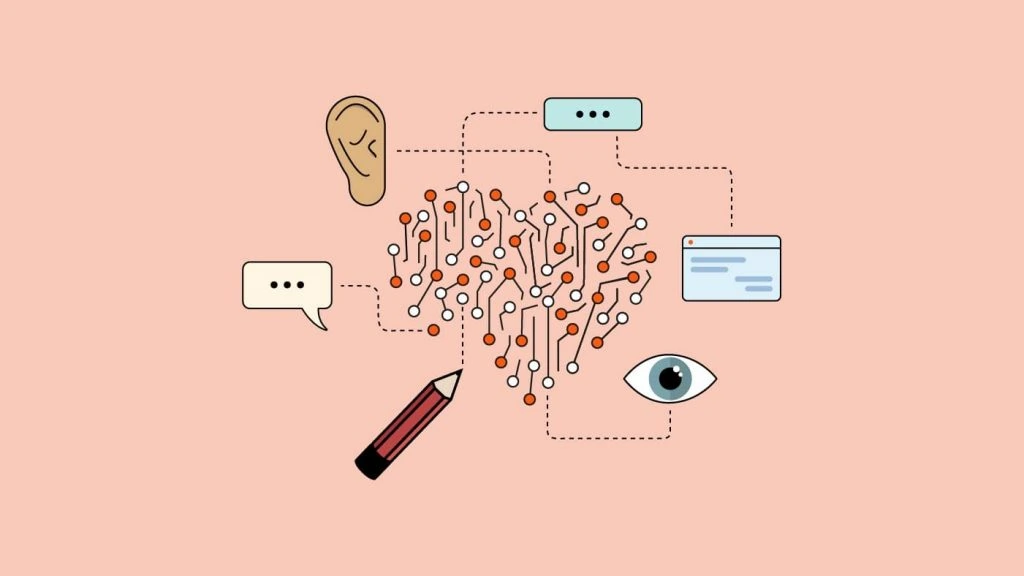AI in Graphic Design: The Future of Creativity
Artificial Intelligence (AI) is reshaping the graphic design landscape, revolutionising industries, including the creative field. AI-integrated graphic design tools are unlocking new possibilities and streamlining creative processes.
This article explores the role of AI in graphic design, its impact on designers, ethical considerations, challenges, limitations, and the promising future of AI-driven design.
Table of Contents
The Role of AI in Graphic Design
AI has revolutionised graphic design, profoundly altering how designers conceive and execute their ideas. One of its most impactful contributions is AI-powered design tools, which have brought unprecedented efficiency and innovation.
AI-Powered Design Tools
The integration of AI-powered design tools has revolutionised the graphic design landscape. These tools use machine learning algorithms to analyse vast data, including user preferences, design trends, and artistic choices.
AI leverages this knowledge to suggest design elements, colour schemes, and layouts that align precisely with a user's project requirements. For instance, industry leader Adobe, with its AI integration known as Adobe Sensei, empowers designers to create visually stunning graphics with unparalleled ease and speed, enhancing the quality and efficiency of design workflows.
Popular tools like Canva and Figma have also embraced AI capabilities to streamline the design process. Canva's AI-driven platform offers users personalised design recommendations, making it user-friendly for designers of all levels. On the other hand, Figma employs AI to optimise design collaboration and prototyping, allowing teams to work seamlessly and efficiently on design projects.

Automated Image Editing
AI's involvement in graphic design goes beyond conceptualisation, extending to automated image editing—a groundbreaking application of AI. Advanced AI algorithms, like those found in Adobe Photoshop and Pixlr, can seamlessly remove imperfections in images, enhance lighting and contrast, and meticulously retouch photographs.
This saves significant time for designers while ensuring the final visuals are of the highest quality and ready for immediate publication. The unique ability of AI to perform batch processing further streamlines the image editing process, enabling designers to apply consistent edits across multiple images simultaneously, maintaining a cohesive and polished look throughout their projects.
The integration of AI-powered image editing tools has undoubtedly elevated the efficiency and precision of the design process, empowering designers to produce exceptional visuals quickly.

Personalised Design Recommendations
One of the most impactful aspects of AI in graphic design is its capacity to provide personalised design recommendations. By analysing user data, AI algorithms gain valuable insights into individual design preferences, enabling them to offer tailor-made suggestions that cater to each designer's unique tastes and requirements.
From suggesting design templates ideally suited to a particular project's theme to recommending fonts and colour palettes that resonate with a designer's style, AI fosters a democratising approach to the creative process.
Designers of all skill levels can now access resources that align perfectly with their artistic visions, facilitating a more engaging and user-friendly design experience for all.
Examples of Personalised Design Recommendations:
- Font Selections Aligned with Target Audience's Typography Preferences: AI-driven design tools can analyse the preferred typography styles of a target audience and suggest fonts that resonate with their tastes. By understanding the unique typography preferences of the audience, designers can create visuals that effectively communicate the intended message and evoke the desired response.
- Tailored Layout Recommendations for Different Mediums or Platforms: AI-powered design solutions offer optimised layout suggestions for specific mediums or platforms. Whether it's designing for print, web, or social media, these recommendations ensure that the visual elements are presented cohesively and captivate the target audience effectively.
- Colour Palette Suggestions for Desired Brand Impact: AI's ability to analyse brand objectives enables it to recommend colour palettes that evoke the desired emotional impact. By aligning the colours with the brand's personality and message, designers can establish a solid and consistent visual identity that resonates with the audience.
- Culturally Relevant Design Elements for Target Audience: Personalised design recommendations consider the target audience's cultural preferences. AI-powered tools can suggest design elements and visuals that align with the cultural context, ensuring the designs are relatable and meaningful to the intended audience.
- Image Selections Catering to User's Industry: AI-driven systems can understand a user's industry and propose relevant images that suit the specific context. Whether it's product photography, illustrations, or stock images, these recommendations ensure that visuals complement the content and resonate with the industry's aesthetics.
- Personalised Resume Templates Highlighting Skills and Experience: AI resume builders, like ResumeKit, offer personalised design recommendations for creating impactful resumes. By understanding the individual's skills and experience, these tools provide custom resume templates that effectively showcase the applicant's strengths, enhancing their chances of securing desired job opportunities.
Enhancing Creativity with AI
AI has emerged as a game-changer in graphic design, elevating the creative process to new heights by augmenting and amplifying designers' capabilities. Through AI's integration into the design workflow, various aspects of the creative process are optimised, unleashing designers' potential for unparalleled innovation and artistic expression.
Streamlining Workflow Processes
AI's automation of repetitive and time-consuming tasks has significantly benefited graphic designers worldwide. By entrusting image resizing, colour adjustments, and file organisation to AI-powered tools, designers can allocate more time to ideation, experimentation, and problem-solving. This enhanced efficiency speeds up the design process and fosters an environment where designers can explore new creative frontiers.
Designers across the globe have embraced AI-driven solutions like Sketch, featuring machine learning-powered plugins that automate various design tasks. From content population to symbol management, Sketch's AI-powered plugins streamline workflow processes, empowering designers to focus on refining their design concepts and delivering exceptional visual experiences.
The seamless integration of AI into design workflows has revolutionised how designers approach their work, allowing them to unleash their creativity and achieve remarkable outcomes.

Exploring New Design Possibilities
AI's impact on the design landscape transcends mere optimisation, ushering in an exciting era of exploring uncharted design possibilities globally. AI-generated art has revolutionised the creative world by seamlessly combining diverse artistic styles, reimagining classic compositions, and birthing entirely novel visual expressions.
As designers collaborate with AI as creative partners, they embark on a journey of innovation and exploration previously deemed unimaginable. This fusion of human creativity and artificial intelligence opens up a boundless realm of experimentation, encouraging designers worldwide to break away from traditional norms and embrace avant-garde concepts.
Designers worldwide have been harnessing AI-driven tools like Artbreeder, which employs machine learning algorithms to merge and evolve images, giving rise to unique and mesmerising artwork. By blending styles, subjects, and concepts, Artbreeder inspires designers to adopt a more experimental, boundary-pushing design ethos.

Generating Unique Visual Elements
AI's prowess in generating unique visual elements breathes new life into graphic design. Through AI, designers can access a wealth of custom illustrations, intricate patterns, and artistic flourishes that infuse their creations with a distinctive identity. Embracing AI-generated visual elements ensures that designers can craft visually arresting graphics that resonate with their brand's essence, helping them stand out amidst a sea of content.
Pablo Picasso once remarked, “Computers are useless. They can only give you answers.”
However, in today's context, Picasso's words hold a different meaning. Through its ability to generate custom visual elements, AI offers designers many creative answers, inspiring their design choices and sparking the emergence of unique and unforgettable artworks.
Designers globally have embraced AI-powered platforms like Easil, which provides a vast library of customisable design templates and elements. By incorporating AI-generated illustrations, graphics, and patterns from platforms like Easil, designers can add an extra layer of originality to their work, elevating their creative expression and captivating audiences worldwide.

The Impact on Graphic Designers
As AI technologies revolutionise graphic design, the roles of graphic designers undergo a significant shift. AI's capacity to handle repetitive tasks liberates designers' time, enabling a greater focus on strategic and creative aspects of their work. However, this transformation demands a change in designers' skill sets and approaches to collaborate with AI-driven systems effectively.
Shifting Roles and Skill Sets
In the AI-driven landscape, graphic designers must adapt and acquire skills that complement AI technologies. Beyond technical proficiency, designers must leverage their creative instincts and interpret data-driven insights from AI tools.
Understanding AI-generated data analysis helps designers make informed decisions, optimise user experiences, and tailor visuals to specific audience preferences. Interdisciplinary collaboration with data scientists and AI specialists allows designers to fully harness AI's potential and integrate it into the design process.
Skills to Adapt and Acquire:
- Data Analysis and Interpretation: Designers can use data-driven insights from AI tools to inform design decisions and tailor visual elements to audience preferences.
- Human-Centric Design Thinking: Emphasising empathy and understanding user needs allows designers to complement AI technologies by injecting emotion and storytelling into design work.
- Collaboration and Interdisciplinary Communication: Working effectively with AI specialists and data scientists fosters seamless integration of AI technologies into the design workflow.
- Ethical Design Considerations: Being aware of ethical implications related to AI-generated content helps designers maintain responsible and respectful practices in their creative work.
- Creative Problem-Solving: Embracing AI as a means of creative problem-solving unlocks novel opportunities, inspiring designers to tackle design challenges with original and inventive solutions. This dynamic approach pushes the creative boundaries within the AI-driven design landscape, fostering innovation and exploration.
Designers can enhance their creative process by utilising AI-powered tools in numerous ways. Here are a few examples:
- Ideation and Concept Generation: AI can assist designers in generating design ideas and concepts, providing a wealth of inspiration and alternative approaches.
- Automated Image Editing: AI-driven image editing tools can efficiently handle tasks like retouching and colour adjustments, allowing designers to focus on more complex aspects of their designs.
- Data-Driven Design Decisions: AI's ability to analyse user data and trends can inform designers' decisions, ensuring that designs align with audience preferences and yield impactful results.
- Personalised Design Recommendations: AI-powered platforms can suggest customised design elements, such as fonts, colours, and templates, tailored to individual project requirements and brand identities.
Collaboration between Humans and AI
The future of graphic design hinges on the seamless collaboration between human creativity and AI technologies. AI is a powerful ally, aiding designers to refine their ideas, optimise design elements, and automate time-consuming tasks.
However, the unique blend of human intuition and creativity brings the human touch to design work, imbuing it with emotion and resonance that connects deeply with audiences. By embracing AI as a collaborative partner rather than a replacement, designers can harness the full potential of AI-driven tools to amplify their creative expression and create impactful visuals that leave a lasting impression.

Embracing Continuous Learning
The Greek philosopher Heraclitus famously stated, “The only constant is change.”
This aphorism aptly applies to the dynamic landscape of AI-powered graphic design. Designers must adopt a continuous learning mindset to remain relevant and thriving in this ever-evolving field. Staying updated on technological advancements and new developments in AI's applications for design is essential for designers to integrate AI tools into their creative processes effectively.
Embracing continuous learning empowers designers to seize opportunities, adapt to emerging trends, and stay at the forefront of innovation, ensuring their designs resonate with audiences in the ever-changing digital landscape worldwide.
Ethical Considerations
As AI technologies continue to reshape the landscape of graphic design, ethical considerations become paramount for designers seeking to harness AI's potential responsibly and ethically. Addressing various ethical concerns ensures the creative process remains authentic, inclusive, and respectful of user privacy and intellectual property rights.
Authenticity and Plagiarism Concerns
Authenticity and plagiarism concerns surrounding AI-generated content have become increasingly significant in design. An illustrative example of this issue is the AI-generated artwork, “Portrait of Edmond de Belamy,” created by the Obvious art collective.
The creation of this painting sparked debates about AI's role in art creation and the attribution of authorship. To maintain ethical standards, designers must exercise caution when using AI-generated assets, ensuring their work respects copyright and intellectual property rights. Being mindful of the origin and ownership of AI-generated content is essential for designers to uphold originality and credibility in their creations.
In early 2023, a group of artists recently filed a class-action lawsuit against AI art tool providers, Midjourney and Stability AI. The lawsuit alleges copyright infringement, claiming that these companies violated the rights of millions of artists.
Midjourney and Stability AI were trained using vast datasets comprising billions of internet images. Determining whether AI art tools violate copyright law can be challenging due to the sheer scale of the training database. Nevertheless, AI tools create new images based on the knowledge acquired during their training.
This lawsuit highlights the complex legal implications surrounding AI-generated content and raises essential questions about the responsibility of AI tool providers and designers in respecting intellectual property rights. As the use of AI tools in design continues to grow, designers must stay informed about copyright laws and ethical guidelines, ensuring that their creative work remains ethically sound and legally compliant.

Bias and Diversity in Design
AI algorithms used in design processes can unintentionally perpetuate bias, leading to a lack of diversity and inclusivity in visual representation. For instance, AI-powered image recognition systems may need more diverse training data to identify individuals with darker skin tones accurately.
Designers must proactively address bias in AI-generated content and ensure that their designs promote inclusiveness and represent diverse perspectives. Designers can foster more equitable and culturally sensitive visual representations by curating various datasets and continuously refining AI algorithms.
Ensuring User Privacy and Data Security
Incorporating AI into design tools often involves gathering and analysing user data to deliver personalised recommendations and experiences. Designers and technology executives are responsible for safeguarding user privacy and implementing robust data security measures.
Achieving a balance between personalisation and privacy is crucial, with designers prioritising the anonymisation of user data, obtaining explicit consent, and using encryption methods to safeguard sensitive information from unauthorised access. Upholding stringent data security practices allows designers to build trust with users and ensures their creative tools respect individual privacy rights.
Challenges and Limitations
AI technologies in graphic design have undeniable advantages, but they come with challenges. Designers must navigate ethical considerations, avoiding copyright infringement and promoting inclusivity while being cautious of potential bias in AI algorithms. Preserving human touch and creativity remains crucial for delivering designs that deeply resonate with audiences.
Overreliance on AI Tools
AI tools have undoubtedly revolutionised the graphic design process, offering efficiency and automation that significantly enhances productivity. However, there is a potential risk of overreliance on AI, where designers rely solely on AI-generated solutions without leveraging their creative instincts and critical thinking.
Designers must strike a balance and recognise that while AI can streamline repetitive tasks and offer valuable insights, human creativity remains paramount in crafting unique and emotionally resonant designs. By blending the power of AI with their creative vision, designers can ensure that their work maintains a distinctly human touch and originality that sets their designs apart.

Maintaining Human Touch and Creativity
As designers integrate AI-generated designs into their workflow, they must preserve the human touch and emotional connection that traditional, human-made art possesses. AI algorithms can produce visually stunning designs, but they may need more depth and soul from human expression.
To overcome this limitation, designers must continually infuse their work with personal flair, emotions, and innovative storytelling. Combining handcrafted elements, unique artistic techniques, and thoughtful design choices enables designers to breathe life into their creations and forge a stronger connection with their audience.
Keeping up with Technological Advancements
The field of graphic design is rapidly evolving, driven by continuous technological advancements and emerging trends. Designers face the challenge of keeping pace with these changes to stay competitive and relevant in the industry.
Embracing constant learning and adaptability is essential to navigate the dynamic landscape of design successfully. By staying informed about the latest tools, techniques, and software updates, designers can leverage cutting-edge technologies to enhance their creative process and deliver innovative and compelling designs to clients and audiences alike.
The Future of AI in Graphic Design
The Future of AI in Graphic Design holds immense promise, with evolving technologies empowering designers to streamline workflows and deliver innovative, user-centric design solutions. Embracing AI as a collaborative partner, designers can elevate their creativity and shape a dynamic landscape that resonates with audiences on a deeper level. This transformative journey in graphic design is poised to redefine the industry's future worldwide.
Intelligent Design Assistants
The future of AI in graphic design promises to bring forth more sophisticated intelligent design assistants that can easily handle complex design requirements. These AI-powered assistants will be equipped to analyse project briefs, user preferences, and design trends, offering tailored and data-driven solutions to designers.
By taking care of intricate details, such as layout optimisation, font selection, and colour palettes, these assistants will free designers to focus on high-level conceptualisation and creativity. This symbiotic partnership between human creativity and AI-driven efficiency will streamline the design process, empowering designers to produce exceptional and visually stunning creations.
Augmented Reality and Virtual Design Spaces
AI-driven augmented reality (AR), and virtual design spaces will open up exciting new possibilities for designers. These immersive environments allow designers to visualise their creations in real-time, offering a dynamic and interactive design review process.
With the aid of AI, designers can experience their designs in a virtual world, gaining valuable insights into how the visuals will interact with the natural environment or user interactions. These AR and virtual design spaces will also foster seamless collaboration among remote teams, breaking down geographical barriers and enabling designers to work together in a shared virtual space, revolutionising how design projects are approached and executed.

AI-Driven Design Evolution
The continued advancement of AI capabilities will undoubtedly lead to a transformative evolution in the very nature of design. AI's capacity to learn from vast datasets and analyse user behaviour will enable the development of design solutions that are genuinely intuitive and user-centric.
By understanding user preferences and needs deeper, AI will empower designers to create more personalised and engaging design experiences. From website layouts that adapt to individual user interactions to product designs that intuitively cater to users' desires, AI's influence will shape a new era of innovation finely tuned to the human experience.
Conclusion
AI's integration into graphic design has opened up endless creative possibilities and streamlined processes. Embracing AI tools and collaborating effectively enables designers to reach new creative heights. Ethical considerations must be prioritised, and adaptation to technological advancements is crucial. The future of graphic design relies on a harmonious coexistence of human ingenuity and AI-driven design, shaping a dynamic and transformative landscape.
AI-powered design solutions can go beyond mere tools and become a natural extension of design teams. The true power of AI tools emerges when they learn from and reflect the creator's personality in the final design. Next-gen AI will assimilate knowledge about and from the creator, producing more authentic outputs.
The future of design is bright, with technology empowering more individuals to express their creativity and enriching our world with diverse and exciting creations.
